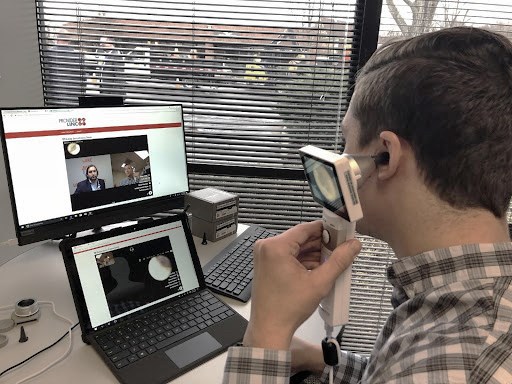In 2019, the Nobel Prize in chemistry was awarded to a team for decades of development work on what most would consider a humble creation: the lithium-ion battery. As Goodenough, Yoshino and Whittingham accepted their prize long in the making, there was a moment to be marked. The lithium-ion battery had finally arrived, and it had arrived as the technology that could change life as we know it and help the world charge into a cleaner, greener, electrified future.
Though the chemistry dates back to the dawn of the 20th century, the first rechargeable lithium battery was invented in the 1970s at the height of the oil crisis and commercialized in the 1990s for use in camcorders: a triumph of precision engineering and scientific ingenuity. Inside the battery canister is an electrochemical experiment in microcosm. Getting down to the basics, each ‘cell’ contains two electrodes with an electrolyte in between. In discharge mode, when the outside electrode terminals are connected to a conducting material (such as a wire), the reactions begin. In the anode of the lithium ion battery cell, electrons and lithium ions are separated and electrons run through the wire outside the cell, creating a current that can power a device. Simultaneously inside the cell, positively-charged lithium ions move through the electrolyte to the cathode where the ions and electrons recombine. The beauty is that these processes can be reversed in charge mode, returning lithium ions and electrons to the anode and restoring the original difference in electrode energy states.
Left: How a lithium-ion battery works; Right: The chemical composition of a lithium-ion battery
The material innovations introduced by Goodenough, Yoshino and Whittingham consisted of a cathode made of lithium-cobalt oxide compound, an anode made from layered carbon and a fluorinated-salt-in-organic-solvent electrolyte. This formula has maintained relevance over thirty-plus years as the baseline for strong and consistently stable battery performance. But as with any experiment, there are opportunities for improvement in changing the variables. Today, many of those opportunities lie in adapting the electrolytes that make the technology work.
“Considering the future of batteries, the electrolyte is probably the most important component. It’s not the most expensive, but it is the most important,” says Dr. Martin Winter, a leading chemist and materials scientist working in the field of electrochemical storage and conversion. “If the electrolyte is not compatible with all the cell components, the battery will never work. Lithium-ion batteries are very good already. Making them better step-by-step is tedious, and maybe not flashy to those talking about the ‘super battery of the future.’ And yet, it’s those step-by-step improvements that will get us to success,” Winter continues.
When it comes to actualizing these step-by-step improvements, academic researchers and manufacturers are putting in the work to develop new fluorinated electrolyte compounds to address present challenges with lithium-ion batteries and unlock two of the biggest opportunities for the technology: scalability and sustainability, for a future where people and planet thrive.
Enhancing Electrolytes for Better Battery Performance
Dr. Martin Winter and his team have researched fluorinated electrolyte compounds for batteries for more than 25 years, looking into the development of new materials, components and cell designs for lithium-ion and metal batteries as well as supercapacitors. Since founding the MEET Battery Research Center at Germany’s University of Münster, Winter has worked with a team of over 300 scientists and alongside numerous global partners in the battery and energy storage spaces. One such partner is Koura, with whom Winter and his colleagues have collaborated through E-Lyte Innovations, an electrolyte manufacturer originating from MEET and specializing in advanced applications.
Fluorinated electrolyte compounds have been of particular interest to Winter and others in the battery community as they offer superior electrochemical stability when paired with high-voltage cathode material—in other words, they are essential compounds on the path to better, safer and longer-life batteries with applications in portable electronics and more. Winter and his colleagues have been examining how fluorinated electrolyte components can be adapted to be less flammable or even non-flammable, offer anode protection for longevity and to increase wettability for better conduction.
Beyond the outcome of creating better lithium-ion batteries for phones, laptops and smart appliances, adjustments to electrolyte formulations can accelerate the “EV-olution”. While lithium-ion battery chemistry was not originally developed to power electric vehicles, it is being adapted now to those ends. For stable operation in a variety of extreme temperature conditions, the replacement of non-fluorinated electrolyte salts, solvents and additives with fluorinated ones can make for less viscosity and resistance in low temperatures, which have historically resulted in reduced power.
“Considering that fluorine has specific properties that non-fluorinated compounds do not have when it comes to optimal electrolyte performance, fluorine salt production needs to be managed by a party with long-standing fluorine expertise for high-performing reproduction in local markets. In addition, replacing non-fluorinated solvents with fluorinated solvents in the electrolyte chemistry can make a complete difference to what we have today as batteries to power EVs.”
These step-by-step improvements can mean addressing present battery performance issues and range anxiety around EVs. They can extend into advancing battery chemistries that can power fuel-cell vehicles, robotic and automation technologies, medical wearables and sensors for health monitoring and even grid-scale energy storage technologies. There’s potential too to make these components readily available in local markets as well as environmentally responsible: a greenfield idea.
Powering a Future of Possibilities
Koura is a long-standing global leader in the development, manufacture and supply of fluoroproducts that advance lives, whether through developing sustainable medical propellants that power 75% of the world’s metered-dose inhalers, pioneering a range of low global warming potential refrigerants or enhancing lithium-ion battery electrolytes to result in people and planet-friendly formulations.
Today, the Koura team is working closely with its customers and manufacturers to develop customized fluorinated battery electrolytes and materials that offer improved safety, performance and environmental outcomes, with upcoming commercial launches slated for this year. In addition, Koura was recently awarded a grant from the U.S. Department of Energy (DOE) with the Argonne National Lab (ANL) to develop improved production processes for fluorinated battery substances with higher voltage stability, low flammability and next-generation silicon conductivity at industrial scale.
“Electrolytes are a key part of Koura’s strategy for battery efficiency. We are undergoing highly technical work to analyze and understand the materials we use and how they behave in various environments as well as collaborating with our customers and battery manufacturers to optimize designs and ensure they are both consumer and environmentally friendly. Our ultimate goal is to provide innovative solutions to any battery performance challenges while remaining committed to practices that advance life around the world—we are ultimately shifting up to a circular fluorine economy.”
Koura is on the path to become one of the key suppliers of fluorinated salt electrolytes in Europe, the UK and the U.S., given the company’s raw material assets and strategic partnerships that contribute to meeting high demand for salts and binders outside of Asia’s crowded market. Think first about stable, scalable and local electrolyte supply chains. And then think beyond scalability to recyclability: an area that can be world-changing in its impact.
Presently, the recycling rate of lithium-ion batteries is problematic, with less than 10% of materials recycled due to high equipment and facility costs needed for smelting and comparatively low recovery of valuable components, according to data from the American Chemical Society1. But addressing battery recycling could lower manufacturing costs, cut development time and material extraction impacts, reduce leaching of pollutants into soil and groundwater supplies and even further enhance the security of supply chains. While battery electrolytes can already be thermally recycled, considering recycling in the electrolyte formulation process (i.e. even before cell making), could result in significant process improvements. Koura is investing in these circular approaches today through internal and external initiatives that make recycling and reuse of key battery materials such as lithium, fluorine and others commercially viable.
Imagine a future where connectivity to a world’s worth of information and services is the guarantee for everyone, from computers that fit comfortably in pockets and operate for days at a time on single charges. Where EVs power up in family driveways and electric buses pass quietly and cleanly down city streets, through all seasons. Where sensors designed to monitor chronic health conditions are safe enough to be installed under the skin, fueled by microbatteries. Where grid-scale storage technologies are ubiquitous, running on bountiful wind, water and sun—and once retired, have their batteries recycled. Imagine that this future is right around the bend.
Thanks to the work being done now, it is. And the lithium-ion battery is humble no more.
1 Jacoby, Mitch. “It’s time to get serious about recycling lithium-ion batteries.” Chemical & Engineering News, American Chemical Society, Volume 97, Issue 28, July 14, 2019, https://cen.acs.org/materials/energy-storage/time-serious-recycling-lithium/97/i28. Retrieved 14 April 2021.





